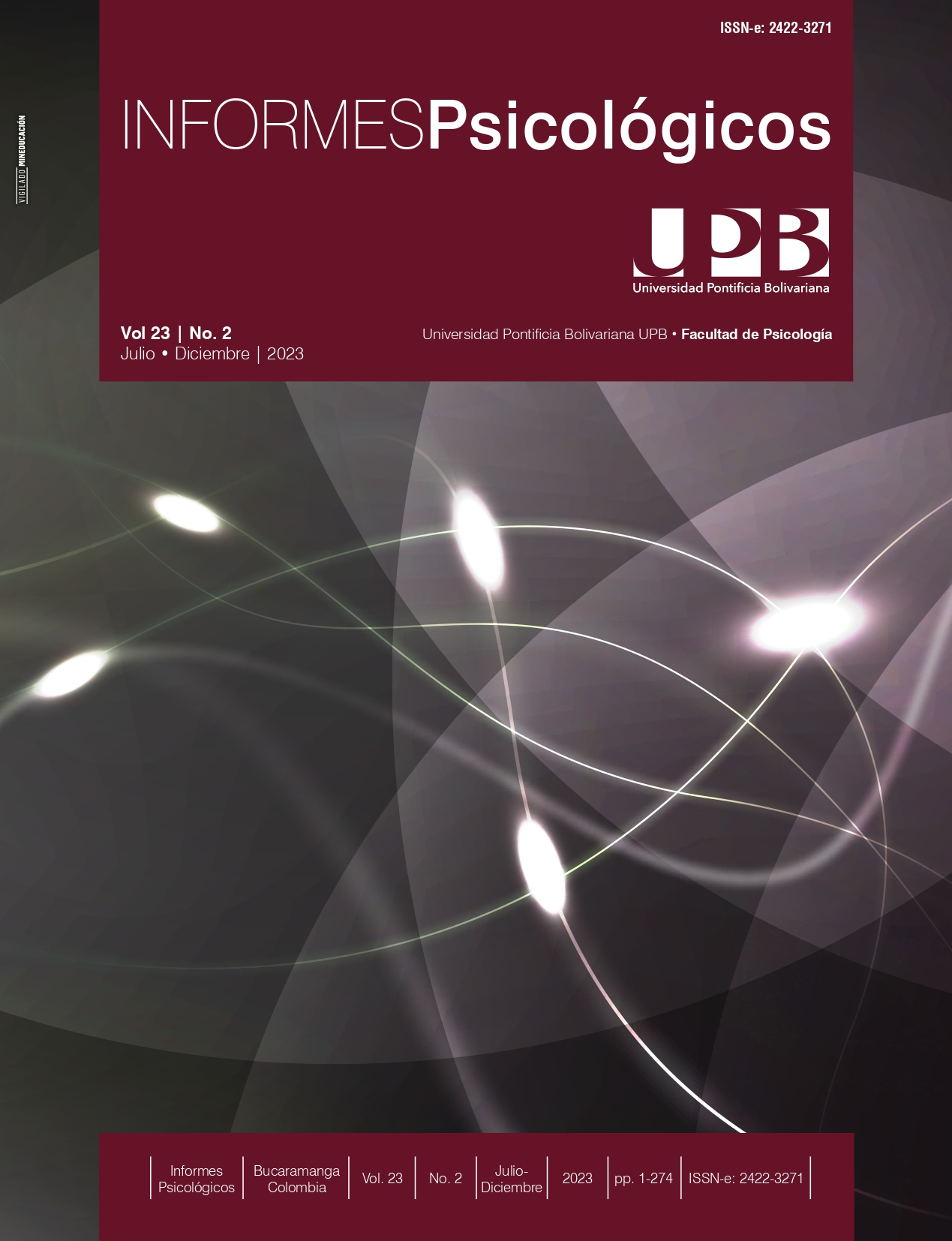Adaptación de la Escala de Síndrome de Boreout para trabajadores mexicanos
Contenido principal del artículo
Resumen
Se adaptó la versión venezolana de la Escala de Síndrome de Boreout para trabajadores mexicanos. Se incluyeron reactivos adicionales a la escala original, con el propósito de incorporar el factor de sobrecarga de trabajo imaginaria, el cual hace referencia a las principales estrategias pro-Boreout que dificultan la identificación del síndrome. El análisis de contenido mostró adecuación respecto a los aspectos lingüísticos y culturales de la versión original, arrojando el análisis factorial exploratorio de tres factores. De acuerdo con el agrupamiento de los reactivos, se replicaron dos de los tres factores originales y se incorporó el factor de sobrecarga de trabajo imaginaría. El análisis factorial confirmatorio evidenció un buen ajuste a los datos. La consistencia interna se calculó mediante el alfa de Cronbach, obteniéndose un valor global de α = .81. Los hallazgos sugieren que la escala cuenta con propiedades psicométricas adecuadas para su aplicación en trabajadores mexicanos.
Citas
Abubakar, A., Rezapouraghdam, H., Behravesh, E., & Megeirhi, H. (2021). Burnout or boreout: A meta-analytic review and synthesis of burnout and boreout literature in hospitality and tourism. Journal of Hospitality Marketing & Management, 1, 1-46. https://doi.org/10.1080/19368623.2022.1996304
Cabrera, L. (2014). Síndrome de Boreout: Diseño, confiabilidad y validación preliminar de un instrumento para su medición. Revista Salud UIS, 46(3), 259-265. https://revistas.uis.edu.co/index.php/revistasaluduis/article/view/4502
Daza, D., Plaza, M., y Hernández, H. (2017). Factores de riesgo intralaboral asociados al clima organizacional y su efecto sobre el síndrome de boreout en el sector salud. Revista Espacios, 38, 3-8. http://www.revistaespacios.com/a17v38n58/17385803.html
Diario Oficial de la Federación (2018). Norma Oficial Mexicana NOM-035-STPS-2018, Factores de riesgo psicosocial en el trabajo-Identificación, análisis y prevención. https://www.dof.gob.mx/nota_detalle.php?codigo=5541828&fecha=23/10/2018
Fernández, C. (2017). Adaptación y validación preliminar del cuestionario de medición del síndrome de Boreout en población chilena [Tesis de licenciatura, Universidad de Concepción]. http://152.74.17.92/jspui/bitstream/11594/2519/3/Fern%C3%A1ndez%20Pincheira.pdf
Flores, N., Jenaro, C., Cruz, M., Vega, V. y Pérez, M. C. (2013). Síndrome de burnout y calidad de vida laboral en profesionales de servicios sanitarios. Pensando Psicología, 9, 7-21. https://doi.org/10.16925/pe.v9i16.613
Espino-Orbegoso, M. (2020). Calidad de vida y síndrome de Boreout en trabajadores de una empresa industrial de Pisco-2019 [Tesis de licenciatura, Universidad Privada Anterior Orrego]. https://repositorio.upao.edu.pe/bitstream/20.500.12759/6418/1/REP_PSIC_ MARIAXIMENA.ESPINO_CALIDAD.DE.VIDA.pdf
Grandón, V. (2020). Influencia de dolencias corporales y factores de riesgo ocupacional sobre el Síndrome de Boreout en una empresa de videovigilancia y seguridad [Tesis de licenciatura, Universidad de Concepción]. http://repositorio.udec.cl/bitstream/11594/688/1/Valerie%20Grandon%20Loaiza.pdf
Gil-Monte, P. (2012). Riesgos psicosociales en el trabajo y salud ocupacional. Revista Peruana de Medicina Experimental y Salud Pública, 29, 237-241. http://www.scielo.org. pe/scielo.php?pid=s1726-46342012000200012&script=sci_arttext
Gómez-Tenorio, E. D., y Tapia- García, O. (2013). El síndrome del Boreout, sus estadios y estrategias. Primer Congreso Estatal de Ciencias Administrativas, 1, 52-58. https://www.uv.mx/coatza/admon/files/2013/02/Memoria.pdf
Iacobucci, D. (2010). Structural equations modeling: Fit indices, sample size, and advanced topics. Journal of Consumer Psychology, 20(1), 90-98. https://doi.org/10.1016/j.jcps.2009.09.003
Karatepe, O., & Kim, T. (2020). Investigating the selected consequences of boreout among cabin crew. Journal of Air Transport Management, 82, 101739. https://doi.org/10.1016/j.jairtraman.2019.101739
Kompanje, E. (2018). Burnout, boreout and compassion fatigue on the ICU: It is not about work stress, but about lack of existential significance and professional performance. Intensive Care Medicine, 44(5), 690-691. https://doi.org/10.1007/s00134-018-5083-2
Lance, C., Butts, M., & Michels, L. (2006). The sources of four commonly reported cutoff criteria: What did they really say? Organizational Research Methods, 9(2), 202-220. https://doi.org/10.1177/1094428105284919
Marsh, H., Hau, K., & Wen, Z. (2004). In search of golden rules: Comment on hypothesis-testing approaches to setting cutoff values for fit indexes and dangers in overgeneralizing Hu and Bentler’s (1999) findings. Structural Equation Modeling, 11(3), 320-341. https://doi.org/10.1207/s15328007sem1103_2
Morales, Y. (2021). Síndrome de Boreout en Latinoamérica. [Tesis de Licenciatura, Universidad Señor de Sipán]. https://repositorio.uss.edu.pe/bitstream/ handle/20.500.12802/8625/Morales%20N%C3%BA%C3%B1ez%20Yerka%20Doris. pdf?sequence=1&isAllowed=y
Morán, K. (2017). Estudio psicométrico de una escala para medir el Boreout en trabajadores administrativos [Tesis de Licenciatura, Universidad San Ignacio de Loyola]. https://repositorio.usil.edu.pe/server/api/core/bitstreams/c9fe8be9-cde4-435a-96df- 4f9624187967/content
Organización Mundial de la Salud & Organización Internacional del Trabajo (2021). Teletrabajo saludable y seguro: Resumen técnico. En Teletrabajo saludable y seguro: Resumen técnico. https://www.who.int/publications/i/item/9789240040977
Organización Mundial de la Salud (2022). Salud ocupacional. https://www.who.int/health-topics/occupational-health
Özsungur, F. (2020a). The Effects of Mobbing in the Workplace on Service Innovation Performance: The Mediating Role of Boreout. Journal of Business Research-Turk, 12(1), 28-42. https://doi.org/10.20491/isarder.2020.826
Özsungur, F. (2020b). The mediating role of boreout in the effects of mobbing on service innovation performance. Asia Pacific Journal of Innovation and Entrepreneurship, 14(2), 203-213. https://doi.org/10.1108/APJIE-12-2019-0085
Panagioti, M., Panagopoulou, E., Bower, P., Lewith, G., Kontopantelis, E., Chew-Graham, C., Dawson, S., Van Marwijk, H., Geraghty, K., & Esmail, A. (2017). Controlled Interventions to Reduce Burnout in Physicians: A Systematic Review and Meta-analysis. JAMA Internal Medicine, 177, 195-205. https://doi.org/10.1001/jamainternmed.2016.7674
Rothlin, P. & Werder, P. (2009) El nuevo síndrome laboral Boreout, recupera la motivación. De bolsillo. Vilotta, N., Solanes, A., y del Rio, B. (2019). El Síndrome de Boreout: comparación entre trabajadores españoles e italianos. Conferência -Investigação E Intervenção Em Recursos Humanos, (9). https://doi.org/10.26537/iirh.vi9.2852
Villavicencio-Ayub, E., Jurado-Cárdenas, S., & Valencia-Cruz, A. (2015). Work engagement and occupational Burnout: Its relation to organizational socialization and psychological resilience. Journal of Behavior, Health & Social Issues, 6, 45-55. https://doi.org/10.5460/jbhsi.v6.2.47026


